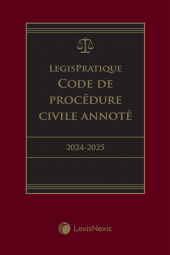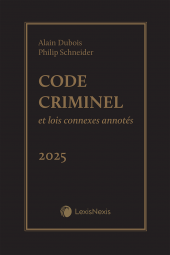Demonstrative Advocacy - Understanding and Constraining Partiality in Adjudication
One Year Subscription Only Terms
Subscribers receive the product(s) listed on the Order Form and any Updates made available during the annual subscription period. Shipping and handling fees are not included in the annual price.
Subscribers are advised of the number of Updates that were made to the particular publication the prior year. The number of Updates may vary due to developments in the law and other publishing issues, but subscribers may use this as a rough estimate of future shipments. Subscribers may call Customer Support at 800-833-9844 for additional information.
Subscribers may cancel this subscription by: calling Customer Support at 800-833-9844; emailing customer.support@lexisnexis.com; or returning the invoice marked 'CANCEL'.
If subscribers cancel within 30 days after the product is ordered or received and return the product at their expense, then they will receive a full credit of the price for the annual subscription.
If subscribers cancel between 31 and 60 days after the invoice date and return the product at their expense, then they will receive a 5/6th credit of the price for the annual subscription. No credit will be given for cancellations more than 60 days after the invoice date. To receive any credit, subscriber must return all product(s) shipped during the year at their expense within the applicable cancellation period listed above.
Détails des produits
**Please note LexisNexis' USBs, CDs and DVDs are not compatible with Mac software.
"The Demonstrative Advocacy Model goes a long way in constraining subjective interpretations, reducing acrimony, and expediting settlement."
-The Honourable Madam Justice Ellen M. MacDonald, Ontario Superior Court of Justice
Combating Bias in Litigation
Bias exists in every person and is based on his or her life experience. Bias occurs in the courtroom because judges' life experiences have a significant impact on any hearing. Language-based evidence, in particular, is subject to this unfortunate reality.
Demonstrative Advocacy - Understanding and Constraining Partiality in Adjudication presents a ground-breaking scientific solution to this centuries-old issue. Demonstrative Advocacy replaces mere language-based evidence with strategically combined words and images to accurately communicate your client's true conditions and substantiate your case theory.
Author Hassan Fancy, certified as a Specialist in Civil Litigation, is currently co-lead counsel in an unprecedented $3.5 billion dollar class action lawsuit against the Ontario Lottery and Gaming Corporation representing pathological gamblers. Using Demonstrative Advocacy, he successfully sued the OLGC in 2007 on the same grounds asserted in the class action.Discover How To
- Prepare and submit a Book of Demonstrative Evidence to the court or tribunal
- Apply the six purposes of Demonstrative Advocacy and show the story
- Help the Court to correctly comprehend the truth of your case theory within 10 minutes
- Show the "pattern in the evidence" in support of your expert's report using Demonstrative Graph theory
- Protect your witness from opposing counsel's spin during cross-examination
- Visibly expose the errors in the opposing expert's theory
- Prepare a Demonstrative Affidavit illustrating the relevant facts in a manner proven to significantly reduce trial time
- Shatter false stereotypes before the first witness gives evidence
Special Features
- Includes a CD-ROM with all images and sample materials
- Over 200 full-colour visual definition precedents (e.g. cluster diagrams, graphs, etc.) showing how to implement Demonstrative Advocacy to substantiate your case theory
- Illustrated question-and-answer section on advanced topics explaining why to apply Demonstrative Advocacy and how the methodology advances the Rule of Law
- Sample Statement of Law on Admissibility of Books of Demonstrative Evidence
- Sample Books of Demonstrative Evidence used in a variety of court proceedings, including:
- A precedent-setting breach of contract trial
- A precedent-setting complex tort proceeding
- Mediation of a catastrophic personal injury claim
Who Should Buy
- Litigators looking for new, effective ways to present their cases and overcome judicial bias against clients
- Judges seeking to identify, understand and constrain sources of bias in their comprehension of viva voce or documentary evidence and facilitate fact-finding in any hearing
- Academics interested in the theory and constraining of non-pecuniary bias in adjudication, and the impact on Rule of Law
- Colleges teaching law clerk and graphic design courses in Canada and the U.S.
- Medical illustrators who wish to learn the new advocacy model and improve their services to litigation firm
Table des matières
SECTION ONE – The Problem: Bias in the Courtroom
Chapter 1: The Role of Faith in Adjudication
Chapter 2: Faith and Bias: Enforcement of the Judicial Blindfold
Chapter 3: The Meaning of Meaningless Evidence: The Beginning
Chapter 4: The Meaning of Meaningless Evidence: Linguistics and Meta-Mathematics
Chapter 5: Signs, Signs, Signs, and Schematic Bias
Chapter 6: Neuroscience: Schemata and Chemical Endorsements
SECTION TWO – The Solution: Demonstrative Advocacy
Chapter 7: The Solution: The Meaning of Meaningful Evidence
Chapter 8: Visual Definition: Clusters, Layering, Silhouettes, and Illustration and Integration
Chapter 9: Visual Definition II: Demonstrative Graph Theory and Visual Mapping
Chapter 10: Admissibility and the Evidentiary Networks
Chapter 11: From Burns to Words to Burns and Words: A Critical Analysis
Produits liés
-
 LegisPratique – Code de procédure civile annoté 2024-2025Date de sortie: September 30, 2024140,00 $
LegisPratique – Code de procédure civile annoté 2024-2025Date de sortie: September 30, 2024140,00 $ -
 Code criminel et lois connexes annotés, édition 2025 (Volume 1) + Guide du praticien (Volume 2) + Livre électroniqueDate de sortie: August 13, 2024175,00 $
Code criminel et lois connexes annotés, édition 2025 (Volume 1) + Guide du praticien (Volume 2) + Livre électroniqueDate de sortie: August 13, 2024175,00 $ -
 Méthodologie et épistémologie du droit comparé : Diverses méthodes et écolesDate de sortie: July 10, 2024100,00 $
Méthodologie et épistémologie du droit comparé : Diverses méthodes et écolesDate de sortie: July 10, 2024100,00 $
 Lexis Nexis
Lexis Nexis 